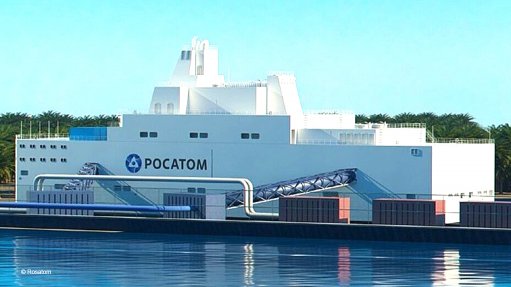
Impression of how an RITM-200 floating nuclear power plant might look
Photo by: Rosatom
The Republic of Guinea has signed a mwmorandum of understanding (MoU) with Russian State-owned nuclear energy and technology group Rosatom to explore the use of sea-based floating nuclear reactors to generate electricity for the coastal West African country. The MoU was signed at last week’s St Petersburg International Economic Forum, in Russia.
“The cooperation involves joint work on developing a power supply solution both to industrial and domestic consumers in the Republic of Guinea, deploying floating nuclear power units with RITM-200 reactors, which have already proven efficient,” explained Rosatom Mechanical Engineering Division deputy head Vladimir Aptekarev. “The power supply issue in the African region is urgent, and our main task is to provide a fast reliable and environment-friendly solution for our partners.”
Currently, Guinea and Rosatom were examining how the floating reactors would be deployed in the country and what the terms and conditions governing their deployment and use should be.
The RITM-200 reactor was originally developed to power Russia’s latest generation of nuclear-powered icebreakers, known as Project 22220 Artika-class, each of which is powered by two of these reactors. Three of these ships, which are civilian vessels, are now in service, with four more being built or on order.
Rosatom already had a floating power plant in operation, in the Chukotka region of the Russian Far East. This power plant, named the Akademik Lomonosov, was fitted with two previous-generation KLT-40S reactors, and generated 70 MWe, plus heat, for the adjacent coastal communities. (While a KLT-40S reactor has an output of 35 MWe, the output of an RITM-200 is 50 MWe.)
Rosatom is currently implementing a 2021 contract to supply four floating nuclear power plants (NPPs) to the Baimskaya Copper Mining and Processing project, also in Chukotka. Each of these will be fitted with two RITM-200 units.
Last month, Aptekarev told World Nuclear News that Rosatom was developing an export version of this floating NPP. This would have “enhanced technical and economic performance suited for relatively warm climates”. He further said that talks were “in progress with several countries across different regions of the world, with some negotiations already resulting in signed agreements”.
Rosatom’s business model for the floating NPPs is that it will not sell them, but deploy them to customer locations and sell the electricity that the NPPs generate. The power purchase agreements could have durations of up to 60 years. The floating NPPs need refuelling every seven to ten years.